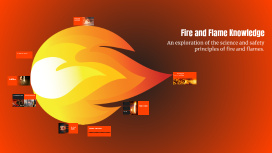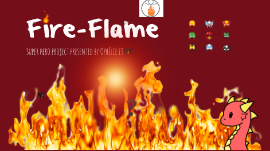Fire and Flame Knowledge
Transcript: Key Insights on Fire and Safety Understanding the fundamental concepts of fire and flames is crucial for ensuring safety and effective prevention strategies. Recognizing different types of flames, their behavior, and the chemistry involved empowers individuals to respond appropriately to fire incidents and mitigate risks in various environments. Continuous education on firefighting techniques and case studies enhances preparedness and resilience against fire hazards. Fire and Flame Knowledge An exploration of the science and safety principles of fire and flames. Case Studies of Notable Fire Incidents Examining significant fire incidents to understand their causes, responses, and lessons learned. 2017 2018 2020 2021 The Grenfell Tower fire in London, which resulted in 72 deaths due to rapid spread of flames and inadequate safety measures. The Beirut port explosion, mistakenly attributed to a fire, highlighted the catastrophic potential of chemical fires and inadequate safety protocols. The Camp Fire in California, which became the deadliest wildfire in California history, leading to significant evac The Surfside condominium collapse in Florida, where a fire incident was initially suspected to be a cause, leading to investigations on building safety standards. Understanding the Essence of Fire and Flames Fire and flames are critical elements that impact safety, scientific research, and daily activities. Understanding their nature is essential for effective prevention and management. The Chemistry Behind Combustion Fire is the result of complex chemical reactions, primarily involving the combustion of fuel in the presence of oxygen. Key elements such as carbon, hydrogen, and oxygen play crucial roles in producing heat, light, and various byproducts during the combustion process. Direct Attack: Immediate Response Indirect Attack: Strategic Approach Direct attack involves applying water or fire suppressants directly onto the flames, allowing for immediate cooling and extinguishing of the fire. This method is typically used when firefighters can safely reach the fire without risk to their safety. Indirect attack, on the other hand, focuses on cooling the fire from a distance by creating a barrier of water vapor or applying suppressants in an area that will affect the fire's spread. This technique is useful in large-scale fires or when visibility is low. Luminous Flames Luminous flames emit light due to the presence of incandescent particles. These flames are typically yellow in color and are commonly seen in candles and gas stoves. They indicate a fuel-rich combustion process. Non-Luminous Flames Types of Flames Non-luminous flames do not emit visible light and are usually blue in color. These flames are more efficient and indicate complete combustion of fuel, as seen in Bunsen burners and propane stoves. Smokeless Flames Different flames can be classified based on their temperature and combustion characteristics, such as smokeless flames, which are typically found in modern combustion systems that minimize waste products. Install Smoke Detectors Implementing smoke detectors and regular maintenance checks can significantly reduce the risk of fire-related injuries and fatalities. Smoke detectors should be installed on every level of a home and tested monthly. Practice a Fire Escape Plan Creating and practicing a fire escape plan is crucial for ensuring that everyone knows how to respond quickly in the event of a fire. This includes identifying exits and meeting points. Fire Safety and Prevention Strategies Fire Behavior and Characteristics Store Flammables Safely Keeping flammable materials away from heat sources helps minimize the risk of accidental fires. Regularly check storage areas for proper organization and safety. Understanding fire dynamics is crucial for safety and prevention strategies. Educate on Fire Risks Educating individuals about fire risks and safety practices can contribute to a culture of prevention. Workshops and training sessions can enhance awareness and preparedness. Growth Phase Fully Developed Phase Decay Phase Ignition Phase Once ignited, the fire enters the growth phase, where it begins to consume surrounding materials, increasing in size and intensity. At this stage, the fire reaches its peak intensity, consuming all available fuels and producing significant heat and smoke. The fire starts when a combustible material reaches its ignition temperature, aided by an oxidizer, usually oxygen. Finally, the fire enters the decay phase where it begins to diminish as fuel is exhausted, leading to a drop in temperature and intensity.

















